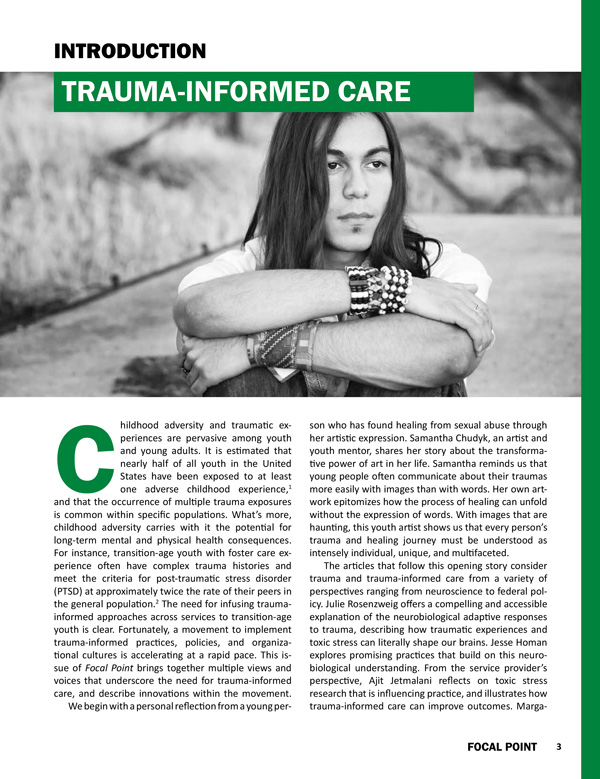
Abstract: The introduction to this issue of Focal Point highlights a variety of perspectives that examine the effects of trauma, the need for trauma-informed care, and how these methods can be incorporated into organizational culture and policy.
"Introduction: Trauma-Informed Care" (2015)
By John D. Ossowski & Julie M. Rosenzweig
Childhood adversity and traumatic experiences are pervasive among youth and young adults. It is estimated that nearly half of all youth in the United States have been exposed to at least one adverse childhood experience,1 and that the occurrence of multiple trauma exposures is common within specific populations. What's more, childhood adversity carries with it the potential for long-term mental and physical health consequences. For instance, transition-age youth with foster care experience often have complex trauma histories and meet the criteria for post-traumatic stress disorder (PTSD) at approximately twice the rate of their peers in the general population.2 The need for infusing trauma-informed approaches across services to transition-age youth is clear. Fortunately, a movement to implement trauma-informed practices, policies, and organizational cultures is accelerating at a rapid pace. This issue of Focal Point brings together multiple views and voices that underscore the need for trauma-informed care, and describe innovations within the movement.
We begin with a personal reflection from a young person who has found healing from sexual abuse through her artistic expression. Samantha Chudyk, an artist and youth mentor, shares her story about the transformative power of art in her life. Samantha reminds us that young people often communicate about their traumas more easily with images than with words. Her own artwork epitomizes how the process of healing can unfold without the expression of words. With images that are haunting, this youth artist shows us that every person's trauma and healing journey must be understood as intensely individual, unique, and multifaceted.
The articles that follow this opening story consider trauma and trauma-informed care from a variety of perspectives ranging from neuroscience to federal policy. Julie Rosenzweig offers a compelling and accessible explanation of the neurobiological adaptive responses to trauma, describing how traumatic experiences and toxic stress can literally shape our brains. Jesse Homan explores promising practices that build on this neurobiological understanding. From the service provider's perspective, Ajit Jetmalani reflects on toxic stress research that is influencing practice, and illustrates how trauma-informed care can improve outcomes. Margaret Blaustein and Kristine Kinniburgh highlight how the effects of trauma can compromise crucial developmental capacities. Their explanations of how young people with trauma histories may not have yet acquired the coping and relational skills generally expected of persons their age are powerful reminders that service delivery changes are needed.
Traumatic experiences that alter our life trajectories can also include social attitudes and systemic discriminatory practices. Melanie Funchess, a parent, describes how the roots of trauma are found in the everyday lived experiences of oppression. The story of her Black, adolescent son illustrates the effects of historical and cultural trauma on persons of color. Unfortunately, his story is one that far too many young Black men can relate to – being subjected to prejudicial treatment by counselors, school officials, and the police. Melanie recalls the overwhelming task of trying to protect all of her children from a trauma that is as pervasive as the air around them. She concludes by sharing advice from her son on how to be a supportive adult.
Diane Yatchmenoff sets the stage for understanding how policies can change – for the better – the experiences of young people, their allies, and the professionals who work alongside them. Her overview of the policy landscape from the agency to the governmental level is filled with real-world examples of trauma-informed policy in action. Guidelines for change are also offered by Rebecca Flatow, Mary Blake, and Larke Huang as they impart SAMHSA's definition of trauma, trauma-informed care, and key identifiers of a trauma-informed organization. Becoming a trauma-informed organization requires critical reflection on existing policies and practices across all levels of the system to begin the transformation process. Toward this goal, Jane Halladay Goldman of the National Child Traumatic Stress Network provides insights on trauma-informed organizational assessments. Her article is filled with questions for organizations to consider in their own movement to become trauma-informed.
Understanding the pervasiveness of trauma and the harm it causes presents new opportunities for those who work with and care for youth and young adults. Becoming trauma-informed has the potential to reshape relationships we have with young people, change our own perceptions of their behaviors, rewrite the policies that guide organizational practices, and encourage all of us to become change agents for a more just society. Throughout this issue of Focal Point, we hope you find useful information to implement trauma-informed care in your everyday work, organizational culture, and policy priorities.
References
- Sacks, V., Murphey, D., & Moore, K. (2014). Adverse childhood experiences: National and state-level prevalence. Retrieved from http://www.childtrends.org/wp-content/uploads/2014/07/Brief-adverse-childhood-experiences_FINAL.pdf
- Salazar, A., Keller, T., Gowen, L., & Courtney, M. (2012). Trauma exposure and PTSD among older adolescents in foster care. Social Psychiatry and Psychiatric Epidemiology, 48(4), 545-551.
Suggested Citation
Ossowski, J. D., & Rosenzweig, J. M. (2015). Introduction: Trauma-Informed Care. Focal Point: Youth, Young Adults, and Mental Health, 29, 3-4. Portland, OR: Research and Training Center for Pathways to Positive Futures, Portland State University.